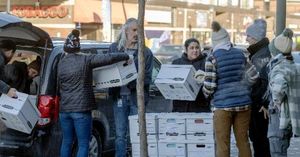Dash cam footage released last week has cast a harsh spotlight on a deadly crash that took place on Florida’s Turnpike near Fort Pierce, reigniting a fierce national debate over immigration policy and commercial trucking regulations. The incident, which occurred on August 18, 2025, involved 28-year-old Harjinder Singh, who was behind the wheel of a semi-truck when he attempted an illegal U-turn, crossing the highway’s median and colliding with a minivan. The violent crash claimed the lives of three people: a 37-year-old woman from Pompano Beach, a 54-year-old man from Miami, and the van’s 30-year-old driver.
Singh, who is now in federal custody facing three counts of vehicular homicide, had a complicated immigration and licensing history that has quickly become the focus of political outrage and regulatory scrutiny. According to NBC6 and dash cam footage reviewed by multiple news outlets, Singh had entered the United States illegally from Mexico in 2018 and subsequently sought asylum. Despite his undocumented status at the time of entry, Singh was able to obtain commercial driver’s licenses (CDLs) from both Washington and California, two of the 19 states (plus the District of Columbia) that allow individuals to receive such licenses regardless of immigration status, as reported by the National Immigration Law Center.
Florida Governor Ron DeSantis wasted no time in using the tragedy to highlight what he called “the failures of the nation’s immigration system.” At a press conference, DeSantis did not mince words, stating, “To have California send this guy in and create havoc for our state, it’s just fundamentally wrong. It can’t just be that we do the right things in Florida, and somehow that’s going to cure what is happening on the ‘Left Coast’ ... California, they do it differently, they invite people to come in illegally, and they provide benefits.” DeSantis further called for Congress to take action, arguing that lawmakers have the power to discipline states that, in his view, do not follow federal immigration law.
The controversy deepened when questions arose about how Singh managed to secure his commercial license. The California Department of Motor Vehicles clarified in a statement that Singh’s commercial driver’s license was a federal REAL ID, issued only after his legal presence in the United States was confirmed through the Federal SAVE System—a federal program that allows states to verify the citizenship and immigration status of individuals applying for government benefits. “The DMV followed all federal and state laws in reviewing and granting Mr. Harjinder Singh his California commercial driver’s license. The federal government confirmed Mr. Singh’s legal presence in the United States,” the statement read. “Mr. Singh’s commercial driver’s license is a federal REAL ID, which he was entitled to receive given the federal government’s confirmation of his legal status.”
Still, the timeline of Singh’s work authorization has been the subject of heated dispute. While California Governor Gavin Newsom’s office claimed Singh obtained a work permit during the Trump administration, Homeland Security spokesperson Tricia McLaughlin countered that the government denied Singh a permit during President Trump’s first term in September 2020 and only granted him one in June 2021, under President Joe Biden. This back-and-forth underscores the complex and often opaque nature of the country’s immigration and licensing systems.
The company that employed Singh, White Hawk Carriers, is based in California and, according to federal records obtained by NBC6, had a relatively clean safety record in the two years preceding the crash. Out of 45 drivers, the company reported no crashes involving fatalities or injuries and no major drug or alcohol violations. However, White Hawk Carriers had been flagged for a range of other issues, including drivers operating beyond legal hours, maintaining false logs, making improper lane changes, distracted driving, and operating with a suspended license. While none of these violations were directly linked to Singh in the lead-up to the crash, they paint a picture of an industry under strain and sometimes struggling to enforce basic safety standards.
Adding to the controversy, Transportation Secretary Sean Duffy announced that the Federal Motor Carrier Safety Administration (FMCSA) is conducting a full investigation into the incident. Secretary Duffy was blunt in his criticism of the current licensing system, particularly the practice of granting CDLs to non-domiciled drivers and those who do not speak English. “It’s a dangerous practice that puts everyone on the road at risk,” Duffy said, echoing concerns from safety advocates who argue that language barriers can impede effective communication and understanding of road signs and regulations.
Supporters of policies that allow undocumented immigrants to obtain driver’s licenses argue that such programs provide a critical lifeline, enabling people to work, care for their families, and travel safely. They point out that licensing undocumented drivers can actually improve public safety by ensuring that more drivers are trained, tested, and insured. However, critics see these policies as a loophole that undermines immigration law and, as in this case, can have tragic consequences.
The crash and its aftermath have exposed the deep divisions between states like Florida and California over how to handle undocumented immigrants and the rules governing commercial trucking. DeSantis’s call for Congressional action was aimed squarely at these differences, urging federal lawmakers to use their power to “discipline the states that don’t follow the law.” Meanwhile, California officials have maintained that their DMV followed all appropriate procedures and that the ultimate responsibility for verifying legal presence lies with federal authorities.
Singh’s actions in the immediate aftermath of the crash have also come under scrutiny. Investigators reported that Singh flew to Sacramento the day after the incident, where he was taken into custody by U.S. Marshals four days later. The sequence of events has raised questions about how quickly and effectively authorities are able to track and apprehend suspects in cases with interstate implications.
As the FMCSA investigation proceeds, families of the victims are left grappling with unimaginable loss. The collision, captured in stark detail by the truck’s dash cam, has become a rallying point for politicians and advocates on all sides of the immigration and transportation safety debates. Whether the tragedy will prompt meaningful legislative or regulatory change remains to be seen. For now, the crash stands as a sobering reminder of the real-world consequences when policy, enforcement, and human error collide on America’s highways.
In the wake of the Fort Pierce crash, the questions swirling around immigration, licensing, and trucking safety have only grown more urgent, with federal and state officials alike under pressure to respond decisively.




